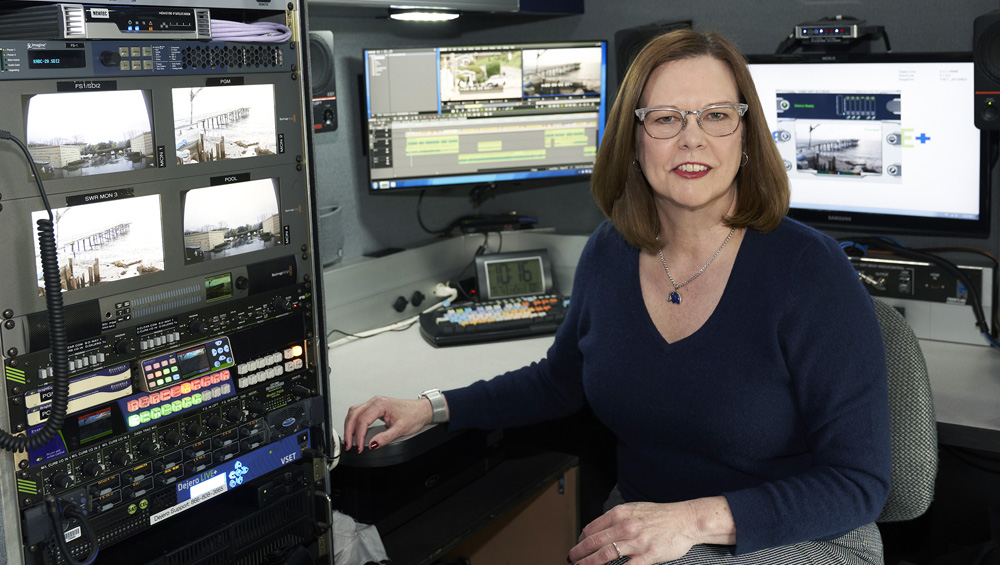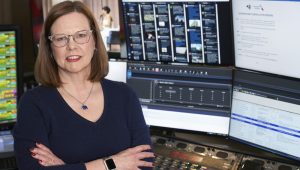
Leading A Tech Revolution At ABC’s Owned TVs


Tish Graham’s ABC O&Os are moving beyond the conventional concept of the recognizable “news van.” Teams in the field utilize the latest technology to produce and distribute content for their multiplatform audiences. (Photo: ABC/Ed Herrera)
When Tish Graham was an 18-year-old freshman at Washburn University in Topeka, Kan., she knew she wanted to go to law school. Then TV happened to her.
“In my sophomore year I had to take an elective class and this TV production class sounded interesting. So, I signed up and knew pretty quickly after I got into the class that law school wasn’t for me, that broadcast and television was where I wanted to be — on the technical side.”
That was in 1977; fast-forward to this April and her resulting career in broadcast television technology will be celebrated with presentation of TVNewsCheck’s ninth annual Women in Technology Leadership Award during the NAB Show in Las Vegas.
Since 2015, Graham has been vice president of broadcast technology for the ABC Owned Television Stations Group. She joined ABC in 1986 and worked at four of the company’s eight O&Os before being named to oversee them all. She is the first woman to lead technology at a television station group and has broken — in the TV industry — what a recent presidential nominee called “the highest hardest glass ceiling.”
Early on, she was interested in “fixing things and putting stuff together” (she built Heathkits as a girl). While at Washburn, she had a professor — Bill Schaffer — who she calls “an amazing mentor.” He was also a producer-director at the local PBS station owned by the university [KTWU Topeka], and she got an internship there. “And then I got a part-time job working four hours a day, three days a week and I ran master control.” The first female to do so, and she adds, she was told a year ago that she’s still the only female to have ever sat behind a switcher at the station.
After graduation in 1980, Graham landed a job at the former KTSB Topeka, working overnight building commercial reels. Shortly thereafter, a friend who was chief engineer at Topeka’s KLDH hired her to help him build the station. “It was an empty building and he and I basically designed it, drew it out, bought the equipment, installed the equipment and brought the station on the air. I learned so much from that — everything from the beginning to the end, all the way to the transmitter.”
Her next move came in 1986 when she joined ABC at its Fresno, Calif., O&O KFSN as an overnight master control operator.
When it’s pointed out to her that six years from graduation to working for ABC seems like a pretty rapid rise, she attributes it to her never saying no when asked if she could do something, whether she knew how or not. “I had no idea how to do it, but I figured if they were going to ask me, then I was going to say yes and I was going to figure it out.”
It was at Fresno that she became involved with the then-new field of IT. She was newscast technical director when the station began installing a newsroom computer system. They had no IT manager and no one with computer experience. “I had a computer at home and the chief engineer said ‘Do you want to be the IT manager?’ and I said ‘absolutely.’
After Graham got the newsroom system up and running and working, she then moved to ABC’s WTVD Raleigh-Durham, N.C., as the assistant IT manager “and that’s where I learned all of my Cisco networking.”
In 2006 she moved to KABC Los Angeles, a position she held until 2011. During her time at KABC she was the lead technology engineer and project manager establishing connectivity to the Disney network in 30 live trucks. She developed and implemented an IP network in each live truck allowing them to access and move content to KABC from the field.
In 2011 she led the engineering/IT department at KTRK Houston as VP of broadcast technology. During her tenure, she managed the transition of the ABC Station Group master control move to Encompass Digital Media, the merging of KTRK’s IT and traditional engineering into the broadcast technology department and numerous station systems installations.

Graham standing at an assignment desk, the origin point for multiplatform coverage. (Photo: ABC/Ed Herrera)
Graham moved into her current position in 2015 and her subsequent leadership in overhauling technology at the ABC Owned Television Stations Group has helped the company adapt to a multiplatform future and changing economic times. In her role, she has demonstrated an ability to make tough decisions and rally her team behind implementing a new plan.
She says the biggest challenge today that’s “driving myself and my team and the technology teams across the owned stations is building the backend workflows so that content can move across any platform like water. So I don’t care if it’s OTT or linear or digital — it just doesn’t matter what the end point is — it’s making it as smooth and seamless at the back end as we possibly can and that is using every technology — cloud-based technology, distribution technology within the television stations, IT technology out in the field — to be able to move content back into the station and then back out to wherever it needs to go and empowering the end user to be able to use that technology.”
A big part of that, she says is maximizing metadata. “We want to get as much metadata into the content as we can with the least amount of manual input, automating that as much as possible so, again, the end user is spending their time writing, producing the content and not worrying about the back end and how it gets moved from point A to point B.”
Thinking back over her career, Graham remembers when she was at KLDH Topeka and the station’s tower came down in a massive ice storm in 1984. “We had only been on the air a couple years and a huge ice storm came through and took the tower down and we were off the air for a week [or a little longer] until we could get back up, you know, obviously on a smaller tower and sharing within the community. It was the scariest thing for all of us that we had ever experienced. Luckily no one was hurt.
“I think back across over my career and there’s always a crisis. There’s always something, but it’s how the teams come together and engineers will do anything to make sure that that signal is on the air or that picture is on the television. The ingenuity that I have seen across the stations that I have worked at over my career is amazing. I always think about the teams that I have worked with and how the old-school engineers who could build anything out of anything and those are the guys I learned from and just that mind set of you just do what you have to do to make sure that you have a picture on the air.”
One of those old-school guys she admires so much is Dave Converse, her predecessor at the station group. Her admiration is reciprocated by Converse: “Tish came to us as a studio and master control operations technician but she was always looking for opportunities to get down in the trenches and out in the field. In addition to her operator duties, she helped re-wire the plant, operated remote vehicles for daily news coverage, and learned — with all of us — the fundamentals of maintaining computers as they migrated from the finance office to the newsroom and on-air operations.
“Tish had a firm grasp of what local television was all about. Keeping the viewer informed and reassured takes an orchestration of reporters, producers and technologists using tools to tell the story. Tish had first-hand experience telling stories and an ability to work with all contributors to the production process. She understood the need to streamline that process as we transitioned from film at 11 to clips streamed anytime of the day to keep the audience satisfied.”
Her appreciation for teamwork remains. “I continue to be amazed by the people at ABC Owned Television and their technology teams, and am honored to be a part of that and to be able to lead this team into modernizing the way that we not only create content, but distribute content. It’s the team work across my career I think that I am the most proud of.”
As a woman in tech, she’s seen some changes during her career. “I have been going to NAB for 20-plus years, and for the first maybe 10 years, I could walk into the women’s bathroom and be the only woman in the bathroom — I could stay in there for an hour and still be the only woman in the bathroom. It’s not like that anymore. There’s actually a line for the bathroom on the women’s side at NAB now and that is very cool.”
































Comments (1)
[email protected] says:
February 7, 2019 at 9:32 pm
ABC only owns 8 stations, the least amount of stations owned by a broadcast network. They could up it to 11 if they would buy from Cox Media the ABC affiliates in Atlanta, Orlando, and Charlotte.